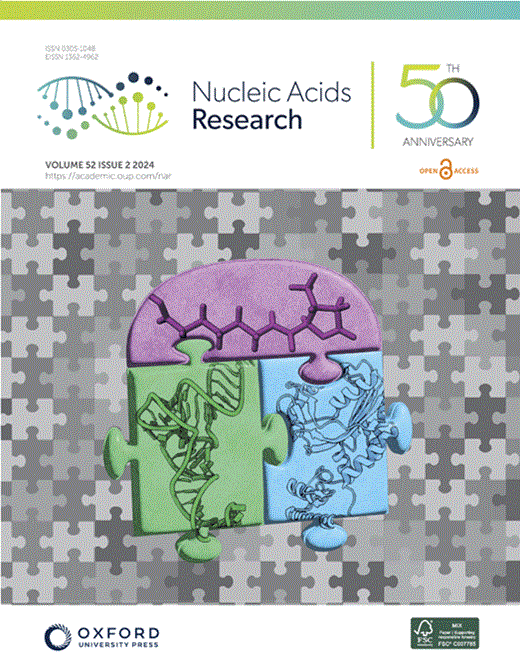The short conserved region-2 of LARP4 interacts with ribosome-associated RACK1 and promotes translation
IF 16.6
2区 生物学
Q1 BIOCHEMISTRY & MOLECULAR BIOLOGY
引用次数: 0
Abstract
LARP4 interacts with poly(A)-binding protein (PABP) to protect messenger RNAs (mRNAs) from deadenylation and decay, and recent data indicate it can direct the translation of functionally related mRNA subsets. LARP4 was known to bind RACK1, a ribosome-associated protein, although the specific regions involved and relevance had been undetermined. Here, through a combination of in-cell and in vitro methodologies, we identified positions 615–625 in conserved region-2 (CR2) of LARP4 (and 646–656 in LARP4B) as directly binding RACK1. Consistent with these results, AlphaFold2-Multimer predicted high-confidence interaction of CR2 with RACK1 propellers 5 and 6. CR2 mutations strongly decreased LARP4 association with cellular RACK1 and ribosomes by multiple assays, whereas PABP association was less affected, consistent with independent interactions. The CR2 mutations decreased LARP4’s ability to stabilize a β-globin mRNA reporter containing an AU-rich element (ARE) to higher degree than β-globin and GFP (green fluorescent protein) mRNAs lacking the ARE. We show LARP4 robustly increases translation of β-glo-ARE mRNA, whereas the LARP4 CR2 mutant is impaired. Analysis of nanoLuc-ARE mRNA for production of luciferase activity confirmed LARP4 promotes translation efficiency, while CR2 mutations are disabling. Thus, LARP4 CR2-mediated interaction with RACK1 can promote translational efficiency of some mRNAs.求助全文
约1分钟内获得全文
求助全文
来源期刊

Nucleic Acids Research
生物-生化与分子生物学
CiteScore
27.10
自引率
4.70%
发文量
1057
审稿时长
2 months
期刊介绍:
Nucleic Acids Research (NAR) is a scientific journal that publishes research on various aspects of nucleic acids and proteins involved in nucleic acid metabolism and interactions. It covers areas such as chemistry and synthetic biology, computational biology, gene regulation, chromatin and epigenetics, genome integrity, repair and replication, genomics, molecular biology, nucleic acid enzymes, RNA, and structural biology. The journal also includes a Survey and Summary section for brief reviews. Additionally, each year, the first issue is dedicated to biological databases, and an issue in July focuses on web-based software resources for the biological community. Nucleic Acids Research is indexed by several services including Abstracts on Hygiene and Communicable Diseases, Animal Breeding Abstracts, Agricultural Engineering Abstracts, Agbiotech News and Information, BIOSIS Previews, CAB Abstracts, and EMBASE.
 求助内容:
求助内容: 应助结果提醒方式:
应助结果提醒方式:


